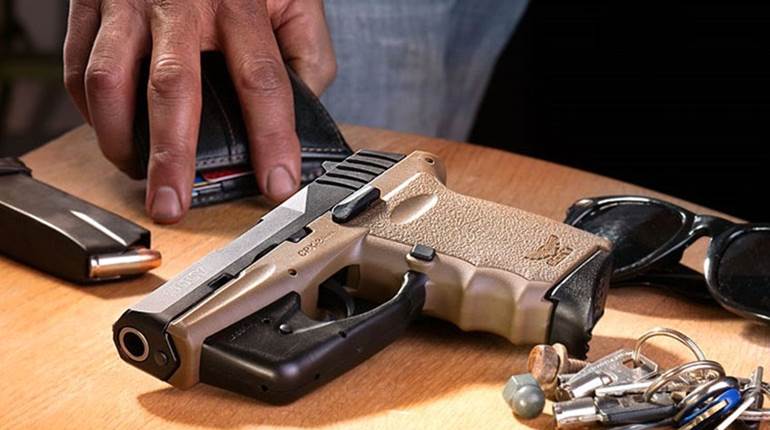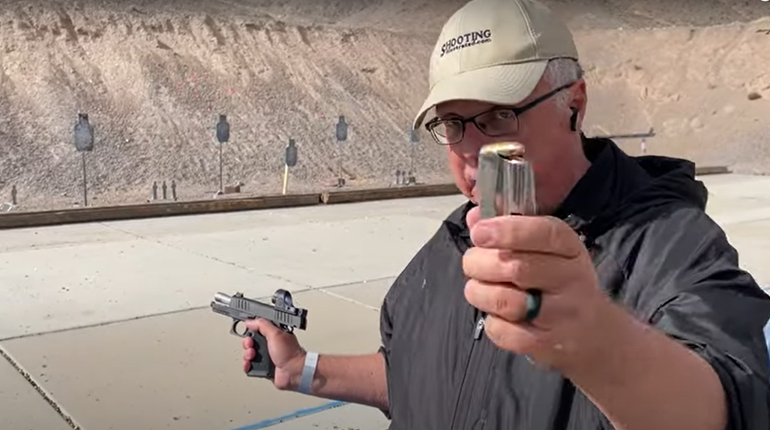
Prior to Y2K, during our spare time as gun magazine editors, two colleagues and I idly argued over what would constitute the ideal "Omega Man" gun, referring to the Boris Sagal-directed, post-apocalyptic science fiction movie The Omega Man, starring our beloved Charlton Heston.
I have obviously dated myself by referencing such an old movie. Today, the Omega Man gun would be described as the firearm for the Zombie Apocalypse.
The idea of the Omega Man gun was simple enough: What would be the one firearm to have in the event of a total social breakdown? Don't think of anything as common as an earthquake, hurricane, financial collapse or NFL lock-out. No, we're talking about a major event here, like a super volcano, nuclear holocaust or viral epidemic—a game-changer. What would be the best firearm to have in that (hopefully) unlikely event?
SPECULATING
Oh, sure. I know what you're thinking: Gun writers don't have anything better to do than imagine the end of the world? I assure you that, as I write this, I am not wearing my Reynolds Wrap fedora nor I am I huddled in an underground bunker. It was the dire predictions about Y2K that started the conversation. However, such hypothetical scenarios are endless fun to speculate about, especially since popular and literary culture is rife with post-apocalyptic books and movies.
Sure, there are guilty pleasure movies like Zombieland, but there are also highbrow meditations on the subject, such as Cormac McCarthy's Pulitzer prize-winning novel "The Road." And, if you indulged in either, you probably gave some thought to the kind of gun you'd like to have in that situation. Why? In most books and movies of the sort, the protagonist's problems could likely be remedied with the right gun. Have you ever noticed that a "psycho killer" movie never has an NRA member among the pool of potential victims?
At the time, not only could we not settle on a gun; we couldn't even agree on a caliber. One selected the 5.56 x 45 mm NATO, as he was former military, while the other editor, an armchair military historian, opted for the 7.62 x 51 mm NATO. I went with the historian.
AT LAST
The reason we couldn't agree, I think, was that no such gun existed. Each had some "flaw" or, more correctly, was designed for a role other than surviving the dystopian landscape of Armageddon.
However, all these years later, I think I just may have stumbled on the exact right firearm for the Omega Man/Zombie Apocalypse scenario.
It is the ArmaLite AR-10 Carbine, specifically the 10A4CBNF 1913, accessorized with a Grip Pod and an ELCAN SpecterDR 1.5-6x scope. Here's why.
CALIBER
The gun would have to fire a military caliber, since ammunition would be limited in an Omega Man scenario and military calibers would be most plentiful. That means 5.56 x 45 mm or 7.62 x 51 mm.
Reputedly, the 5.56 wasn't designed to kill, but to wound. In the conventional wars anticipated at the time of the round's adoption, killing an enemy combatant was considered inferior to wounding him. Killing him put him out of the fight, but wounding him put him out along with the one or two comrades who had to help him from the battlefield.
Furthermore, studies determined that small unit firefights were most often won by sheer firepower. Putting a lot of lead in the air caused the opposition to "melt away." Thus, producing a withering hail of bullets could be more important than the efficacy of the individual rounds, and it is easier to carry and fire a lot of 5.56 mm than it is 7.62 mm cartridges.
The problem, though, is none of that applies in the Omega Man scenario. Your opponent may not have comrades to carry him off the battlefield. They'll be no Evac choppers, no ambulances, no aid stations or hospitals. How can you place a strain on resources that don't exist? It would likely be every man for himself, so you don't want to wound. You want to put your opponent down to stay.
Firepower? Do you really mean to waste ammunition when cartridges are now arguably the most valuable commodity in the world? Each bullet would be so precious that the idea of suppressive fire would be inconceivable. The sniper credo of "one shot, one kill" would be espoused by every survivor lucky enough to be armed.
And what about range? While the 5.56 can be accurate out to 600 yards, it usually requires specialized ammunition at that range and, even then, its terminal effect is questionable. Regular military ball will be hard enough to find in our scenario; forget about specialized rounds. However, 7.62 is good at close range and can more easily make longer shots, and do so with better terminal ballistics.
And since you'd be abandoning the city for safety and to locate food-supermarkets will have been among the first things looted-a rifle wouldn't be only a combat tool. You'd probably have to hunt, too, and the 7.62 is a better caliber for deer, antelope, elk, etc.
You could find yourself anywhere from the mountains to the plains, from forests to deserts, targeting everything from opossums to armored vehicles, so you'd need a versatile round. Given those criteria, the 7.62 would be the way to go.
PLATFORM
As for the gun itself, in the last two decades, the A2 enhancements answered practically all questions about the AR as a design. If you have doubts about it in 7.62 mm, remember that that was the design's original chambering. The AR-10 is not a beefed up AR-15; the AR-15 is a reduced-size AR-10.
Additionally, in the interim since Y2K, the AR has ventured into the hunting fields with much success, such that virtually every major manufacturer is offering AR platforms in big-game calibers, often painted in camo colors.
LENGTH
The choice of the carbine over the rifle speaks again to the need for versatility. Some days you might have to take a long shot at a deer across a neglected farm field. On others, you'll have to enter houses, stores or warehouses, scrounging. While a rifle would be best for the former, the latter requires compactness and maneuverability. The carbine's 16-inch barrel and collapsible stock would provide those attributes. Oh, there'd be a trade-off at extreme ranges, but it would be worth it. Typically, you can afford a miss at 600 yards a lot more than you can at 6 feet.
RAILS
A flat-top receiver that accepts whatever sighting system you might scrounge would be decidedly advantageous. Things like scope rings, tools, etc., would not be in reliable supply. You want a system that can mount the widest variety of sighting options possible with minimal tools, adjustment and hassle.
However, the initial impulse is to eschew accessory rails in the post-apocalyptic scenario. The idea that you'd use something dependent on batteries when no batteries may be available seems silly. However, in our scenario, batteries may be available you just can't rely on that or on anything that requires them. Also, rails aren't just for battery powered components, and not everything that uses batteries is dependent on them. Thus, accessory rails would be a good, no-harm feature.
SIGHTS
The sighting system is undoubtedly the most difficult piece of the puzzle. The strong inclination is to go with iron sights. They're simple and strong. They last and last. The problem is, will your eyesight?
It is much easier to shoot with an optical scope, but they tend to be more fragile. Also what power do you select? Something that is suitable for counter-sniping or long-range hunting is too slow (due to the reduced field of view) for close-quarters combat. And one that is set-up for close quarters is generally too underpowered to be much help at greater distance. Besides, adjusting for one distance or another is laborious and can change the point of impact.
Lasers? Red-dot scopes? Lasers are notoriously difficult to see in broad daylight and, besides, both lasers and red-dots are dependent on batteries, so they're out.
The answer comes from Canada in the form of the ELCAN SpecterDR scope distributed by Armament Technology Incorporated. DR stands for dual role. The scope was developed at the behest of U.S. SOCOM because soldiers in the Middle East were having to transition between engaging the enemy at considerable distance to entering structures and conducting room-to-room searches. Typically, they were having to carry a combination of scopes or one scope and a multiplier, and mounting what was needed for the next anticipated duty.
The SpecterDR puts an end to that. The stout, super-strong scope changes from low-power magnification to medium/high-power magnification with the mere throw of a lever without changing the point of impact. There is a 1-4x but, with a 7.62 x 51 mm, I'd opt for the 1.5-6x. There is no middle ground with the SpecterDR. It goes directly from one magnification to the other with nothing in between. Despite its sophistication, the scope is nearly indestructible and so simple to use that the operator can change magnification in two seconds without breaking cheek weld.
Although the operator can choose between illuminated crosshairs or an illuminated dot, the reticle is actually etched on the glass, so the scope is usable with or without batteries. Further, the scope's adjustments are in the base, not the tube. Sight in, remove the scope, remount it in the same position on the rail and it stays sighted in. And atop the tube is a ghost ring and post, ready to repeal Murphy's Law.
ACCESSORY
The one perfect accessory for the Omega Man gun is the Grip Pod. Even if you're not familiar with this product, the U.S. military and countless law enforcement agencies are. It is a vertical foregrip that mounts (without tools) to the underside fore-end accessory rail, helping you quickly maneuver the gun in tight spaces. But, at the press of a button, two spring-loaded legs shoot out and lock into place, forming a highly effective bipod for long-range shooting. To collapse them, simply squeeze the legs together and shove them up into the grip, where they stow back in place with an audible click, all without batteries.
OTHER OPTIONS
I went with ArmaLite because it's the first name that comes to mind when I think of 7.62 mm ARs. Actually, there are now a number of companies that make ARs in this chambering, including carbines. Also, there is nothing wrong with the Springfield Armory M1A SOCOM II with Extended Top Rail or the DS Arms SA58 Para Tactical Carbine with the optional Short Gas System Rail Interface Handguard. Both would serve as well as the AR and, since both use M14-type magazines, squirreling away extra mags would be easy.
Yep, a dozen or so magazines, several weatherproof battle packs of ammo, a cleaning kit and a bug-out bag, and contrary to the song maybe paranoia won't destroy you.






































